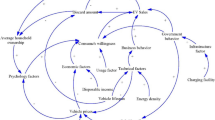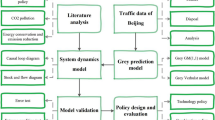Abstract
The low-carbon development of new energy vehicles (NEVs) is critical to achieving the goals of carbon peaking and carbon neutrality. As such, combining gray model theory with system dynamics (SD-GM) and based on the bidirectional-cycle prediction theory, we propose a NEV annual average mileage algorithm considering the impact of the epidemic in China, taking private cars as an example. Then, combining a voluntary advocacy strategy (VA) with the SD-GM theory (VA-SD-GM integration), we establish an energy-saving and carbon-reduction management model. To evaluate the proposed algorithm, we performed a dynamic simulation. The results indicate that the enhanced green scenario enabled significant energy-saving and CO2 reduction performance but would cause side effects in the long term. Compared with the enhanced green scenario, the linkage mode reduced the impact of parking space tension, the number of NEV trips, and the intensification of traffic congestion by approximately 33%, 50%, and 34%, respectively. It effectively suppressed the continuous increase in side effects and had a synergistic effect of carbon reduction, energy conservation, congestion alleviation, and side-effect reduction. The study provides a theoretical basis for optimizing the energy-saving and CO2 reduction path of NEVs.







Similar content being viewed by others
Data availability
Data will be made available on request.
References
Bakhtyar B, Qi Z, Azam M, Rashid S (2023) Global declarations on electric vehicles, carbon life cycle and Nash equilibrium. Clean Technol Envir 25:21–34
Beddows D, Harrison R (2021) PM10 and PM2.5 emission factors for non-exhaust particles from road vehicles: dependence upon vehicle mass and implications for battery electric vehicles. Atmos Environ 244:117886
Bistline J, Abhyankar N, Blanford G, Clarke L, Fakhry R, Mcjeon H, Reilly J, Roney C, Wilson T, Yuan M, Zhao A (2022) Actions for reducing US emissions at least 50% by 2030. Science 376:6596
Böhm M, Nanni M, Pappalardo L (2022) Gross polluters and vehicles’ emissions reduction. Nat Sustain 5:699–707
Chen T, Jou R (2019) Using HLM to investigate the relationship between traffic accident risk of private vehicles and public transportation. Transp Res A 119:148–161
Chen Z, Li B, Jia S (2022) Dynamic evaluation of environmental-economic performance of vehicle emission reduction policy from the perspective of the loss-aversion effect. Sustain Cities Soc 85:104080
Chen Z, Ye X, Jia S (2023) Evaluation of the mid-and long-term effects of a private car driving–restriction policy under the carbon emission peak target. Environ Sci Pollut R 30:44706–44723
Cho H, Olson H (2022) The use of prophylactic antiepileptic medication and driving restrictions for craniotomies among Australian and New Zealand neurosurgeons. J Clin Neurosci 103:112–118
Deng Y, Dong K, Taghizadeh-Hesary F, Xue J (2023) How does environmental regulation affect the double dividend for energy firms? Evidence from China’s EPT policy. Econ Anal Policy 79:807–820
Harleman M, Harris L, Willis M, Ritz B, Hystad P, Hill E (2023) Changes in traffic congestion and air pollution due to major roadway infrastructure improvements in Texas. Sci Total Environ 898(10):165463
Hoffmann C, Thommes K (2022) Clear roads and dirty air? Indirect effects of reduced private traffic congestion on emissions from heavy traffic. J Clean Prod 381:135053
Hsiao C, Yang R, Zheng X, Chiu Y (2023) Evaluations of policy contagion for new energy vehicle industry in China. Energy Policy 173:113402
Jia S, Bi L, Zhu W, Fang T (2023) System dynamics modeling for improving the policy effect of traffic energy consumption and CO2 emissions. Sustain Cities Soc 90:104398
Jia S, Li Y, Fang T (2022) Can driving-restriction policies alleviate traffic congestion? A case study in Beijing, China. Clean Technol Envir 24:2931–2946
Jia S, Yan G (2019) Effects of the policy of air pollution charging fee based on system dynamics and grey model approach. Syst Eng — Theory Pract 39(9):2436–2450 (in Chinese)
Jiang Z, Xu C (2023) Policy incentives, government subsidies, and technological innovation in new energy vehicle enterprises: evidence from China. Energy Policy 177:113527
Klöwer M, Hopkins D, Allen M, Higham J (2020) An analysis of ways to decarbonize conference travel after COVID-19. Nature 583(7816):356–359
Li W (2023) The effect of China’s driving restrictions on air pollution: the role of a policy announcement without a stated expiration. Resour Energy Econ 72:101360
Li X, Mu D, Du J, Cao J, Zhao F (2020) Game-based system dynamics simulation of deposit-refund scheme for electric vehicle battery recycling in China. Resour Conserv Recycl 157:104788
Lin B, Shi L (2022) Do environmental quality and policy changes affect the evolution of consumers’ intentions to buy new energy vehicles. Appl Energy 310:118582
Liu B (2023) Carbon neutralization and automobile: China’s automobile industry zero carbon road. China Machine Press, Beijing (in Chinese)
Liu Q, Wen X, Cao Q (2023) Multi-objective development path evolution of new energy vehicle policy driven by big data: from the perspective of economic-ecological-social. Appl Energy 341:121065
Ma M, Meng W, Li Y, Huang B (2023) Impact of dual credit policy on new energy vehicles technology innovation with information asymmetry. Appl Energy 332:120524
Mou Z, Jin C, Wang H, Chen Y, Li M, Chen Y (2022) Spatial influence of engineering construction on traffic accidents, a case study of Jinan. Accid Anal Prev 177:106825
Qin S, Xiong Y (2022) Innovation strategies of Chinese new energy vehicle enterprises under the influence of non-financial policies: effects, mechanisms and implications. Energy Policy 164:112946
Sun C, Liu B, Sun F (2022) Review of energy-saving planning and control technology for new energy vehicles. J Autom Safe Ener 13(4):593–616
Wang K, Zheng L, Zhang J, Yao H (2022) The impact of promoting new energy vehicles on carbon intensity: causal evidence from China. Energy Econ 114:106255
Wang Z, Liang Z (2022) Annual report on the big data of new energy vehicle in China (2022). China Machine Press, Beijing (in Chinese)
Wu Z, He Q, Li J, Bi G, Antwi-Afari M (2023) Public attitudes and sentiments towards new energy vehicles in China: a text mining approach. Renew Sust Energ Rev 178:113242
Xiao C, Chang M, Guo P, Chen Q, Tian X (2019) Comparison of the cost-effectiveness of eliminating high-polluting old vehicles and imposing driving restrictions to reduce vehicle emissions in Beijing. Transport Res D 67:291–302
Xiong Y, Cheng Q (2023) Effects of new energy vehicle adoption on provincial energy efficiency in China: from the perspective of regional imbalances. Energy 281:128324
Xiong Y, Fan S, Liu X (2018) The difference of fiscal subsidies for new energy vehicles and R&D investment intensity of the manufacturers: an analysis based on the heterogeneity of the manufacturer’s strategic decision. Sci Sci Manag S&T 39(6):72–83 (in Chinese)
Xiong Y, Li Y (2023) Analysing the evolution of new energy vehicle consumption market: a“leading” and “following” consumers’ perspective. Res Transp Bus Manag 47:100944
Yang X, Jiang P, Pan Y (2020) Does China’s carbon emission trading policy have an employment double dividend and a Porter effect? Energy Policy 142:111492
Zhang L, Tong H, Liang Y, Qin Q (2023a) Consumer purchase intention of new energy vehicles with an extended technology acceptance model: the role of attitudinal ambivalence. Transp Res A 174:103742
Zhang Y, Wang S, Yao J, Tong R (2023b) The impact of behavior safety management system on coal mine work safety: a system dynamics model of quadripartite evolutionary game. Res Policy 82:103497
Zhang Z, Guo Y, Feng L (2022) Externalities of dockless bicycle-sharing systems: implications for green recovery of the transportation sector. Econ Anal Policy 76:410–419
Acknowledgements
We thank LetPub (www.letpub.com) for its linguistic assistance during the preparation of this manuscript.
Funding
This research was supported by the Social Science Planning Foundation of Henan Province (grant no. 2022BJJ052), Project funded by China Postdoctoral Science Foundation (grant no. 2021M690889), Key Research and Development Projects of Henan Province (Grant No. 231111110100), Soft Science Research Project of Henan Province (grant no. 232400410057), and Special Fund for Topnotch Talent at Henan Agricultural University (grant no. 30500646).
Author information
Authors and Affiliations
Contributions
Shuwei Jia wrote the original draft; Yuyang Gao and Yuying Guo contributed to data analysis; Haoyi Ma and Yao Li contributed to model validation; Haiping Yu reviewed and edited the paper.
Corresponding author
Ethics declarations
Ethics approval and consent to participate
This article does not involve the ethical problem.
Consent for publication
Not applicable
Competing interests
The authors declare no competing interests.
Additional information
Responsible Editor: Philippe Garrigues
Publisher’s note
Springer Nature remains neutral with regard to jurisdictional claims in published maps and institutional affiliations.
Rights and permissions
Springer Nature or its licensor (e.g. a society or other partner) holds exclusive rights to this article under a publishing agreement with the author(s) or other rightsholder(s); author self-archiving of the accepted manuscript version of this article is solely governed by the terms of such publishing agreement and applicable law.
About this article
Cite this article
Jia, S., Gao, Y., Guo, Y. et al. Energy-saving and CO2 reduction strategies for new energy vehicles based on the integration approach of voluntary advocacy and system dynamics. Environ Sci Pollut Res 31, 14804–14819 (2024). https://doi.org/10.1007/s11356-024-32172-w
Received:
Accepted:
Published:
Issue Date:
DOI: https://doi.org/10.1007/s11356-024-32172-w




